
Single Gas Transformer Monitoring: Debunking the “Smoke Alarm” Myth
A $2 million transformer just failed. Which part of the city could be affected? The hospital district and life-support systems? The financial center processing millions in overnight transactions? Residential neighborhoods that might be experiencing extreme heat or cold?
This isn’t a hypothetical scenario. When transformers fail without warning, they often trigger rolling blackouts that cascade through entire regions. The economic damage begins immediately, with approximately 60% of GDP tied directly to electric power and sustained outages costing billions. The human cost of a prolonged outage is incalculable.
Yet this crisis could be prevented with early warning. Modern dissolved gas analysis can detect incipient faults in a transformer months or even years before catastrophic failure. This allows utilities time to plan maintenance, look at replacements, or redistribute loads. The technology exists. The data is field-proven. The business case is overwhelming.
So why are some utilities still hesitant to deploy single gas (hydrogen) transformer monitors?
The culprit? A persistent myth comparing these sophisticated monitoring systems to simple “smoke detectors.” Utilities can get continuous monitoring data of hydrogen to act as an early alert system. This approach surpasses current annual or periodic oil sampling techniques, which provide only a snapshot in time and often fail to detect impending failures that may occur months later. Hydrogen sensors today provide cost-efficient and accurate monitoring data that minimizes (not prevents) these failure scenarios. However, many utilities still see this proven technology as a smoke alarm solution.
Comparing single gas hydrogen sensor monitors to “smoke detectors” has become too common, with some going so far as to suggest that the “smoke detector” will result in unnecessary service calls—hardly the intended benefit of substation asset monitoring. This comparison isn’t just inaccurate; it’s potentially costly for utilities managing aging transformer fleets in today’s challenging supply environment.
With transformer lead times stretching to 90+ weeks, replacement costs soaring 65% in just a few years, and failure rates that climb as equipment ages, utilities cannot afford to operate on outdated assumptions about monitoring technology. Every day without intelligent monitoring is another day closer to that impossible choice in the control room.
The Smoke Detector Fallacy
To understand why the smoke detector comparison is so misleading, we need to examine exactly how smoke detectors function—and more importantly, how they’re fundamentally limited.
Smoke detectors serve one purpose—they trigger when smoke disperses light or disrupts an electrical current in an ionization chamber. The detection of smoke generates an alarm to prompt immediate action by those in close proximity. But here’s the critical limitation: there is no graduation of severity or urgency. The lowest detectable smoke concentrations trigger the same response as dense and toxic smoke.
Whether it’s a piece of burnt toast or a raging house fire, the smoke detector’s response is identical: an alarm that demands immediate evacuation. This makes perfect sense for life safety—when smoke is present, you leave. There’s no time for nuanced analysis or graduated responses.
This binary, all-or-nothing approach is exactly what utilities fear when they hear transformer monitors compared to smoke detectors. The mental image of constant false alarms from burnt toast triggering the same response as a real fire creates understandable reluctance to deploy monitoring systems.
But transformer monitors are not smoke detectors. Before examining how they differ, consider first why dissolved gas analysis (DGA) monitoring is so valuable in today’s power grid monitoring landscape.
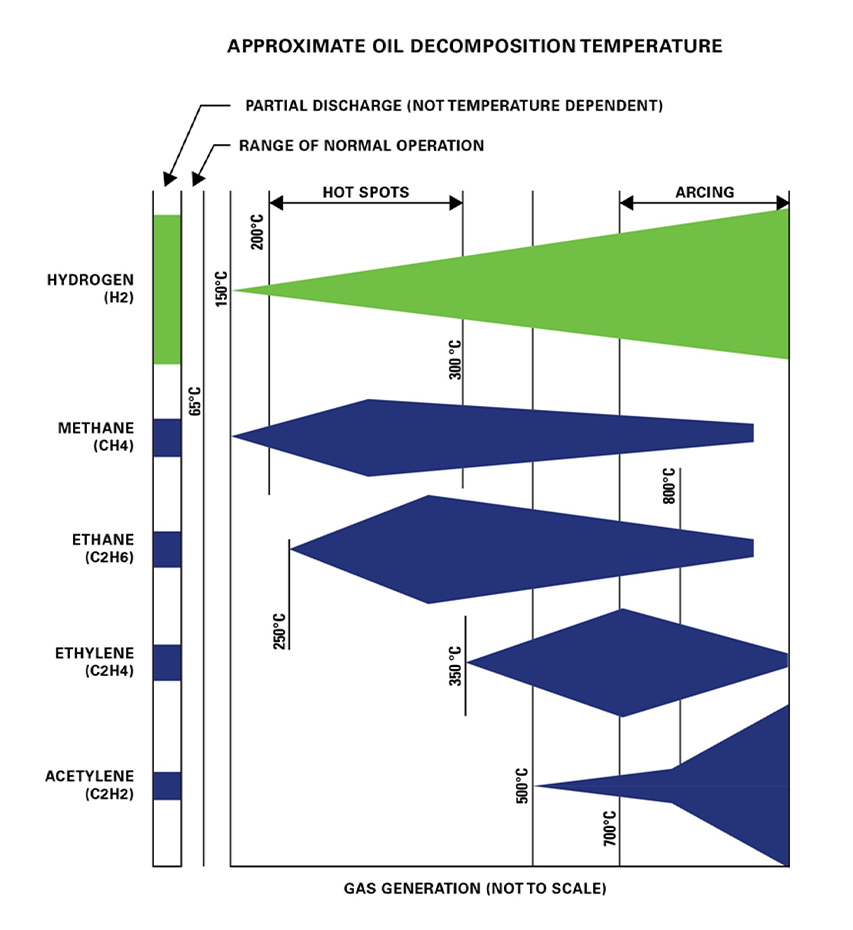
Why DGA Monitoring Matters More Than Ever
Utilities worldwide are recognizing the critical importance of transformer health monitoring. At least 80% of transformer main-tank faults are incipient in nature, with an incipient fault being the gradual deterioration of insulation due to electrical, thermal or chemical stresses such as moisture, overheating or vibration. Unlike sudden short-circuit faults, incipient faults evolve over time, creating localized heat that breaks down the insulating liquids (loosely referred to as oil).
The breakdown generates combustible gases that dissolve into the oil, and the first gas generated is hydrogen—also referred to as the first fault gas or key gas. Put simply, an increase in hydrogen concentration marks the likely onset of a transformer fault. As the fault progresses and gets more severe (hotter), additional hydrogen and new gases are generated. The fault types, temperature ranges and gases are outlined in IEEE C57.104. Knowing all the gas concentrations, typically obtained through manual oil sample analysis and dissolved gas analysis, allows the fault cause and, in part, its severity to be identified.
How Single Gas DGA Monitors Differ from Smoke Detectors
How is a continuous hydrogen-based transformer monitor different from a smoke detector? The answer lies in the actionable insight that the monitor provides:
- Precise concentration measurement: The transformer monitor provides a gas concentration measurement (in parts per million), not just an “H2 present” alarm—the first indicator of severity.
- Rate of change analysis: It provides the rate of change in hydrogen—the second indicator of fault severity. A slow, gradual increase suggests a different action than a rapid spike.
- Contextual intelligence: Most importantly, it provides context by delivering pre- and post-gassing information that guides the action that needs to be taken. Unlike a smoke detector’s single response option, transformer monitors enable multiple response strategies based on the data.
This multi-dimensional analysis is the complete opposite of a smoke detector’s binary response. Where smoke detectors eliminate nuance for life safety, transformer monitors thrive on nuance for asset optimization.
Real-World Case Studies: Intelligence, Not Just Alarms
Consider these three real-life scenarios that demonstrate the sophisticated intelligence of hydrogen sensor systems:
Case Study 1: Through Fault Event
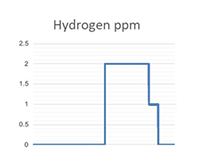 In this example, there was a sudden increase in hydrogen, but to a modest 2 ppm. During the next few days, the gas concentration never increased and actually dissipated. With the information provided by the monitor, it was determined that no further action (no truck roll) was required. This is typical of a through fault that created short-term heating that generated hydrogen—not an incipient fault requiring intervention.
In this example, there was a sudden increase in hydrogen, but to a modest 2 ppm. During the next few days, the gas concentration never increased and actually dissipated. With the information provided by the monitor, it was determined that no further action (no truck roll) was required. This is typical of a through fault that created short-term heating that generated hydrogen—not an incipient fault requiring intervention.
- Saved cost and time of dispatching personnel
- Maintained safety and equipment reliability
- Prevented unnecessary field service calls
Case Study 2: High-Harmonic Environment
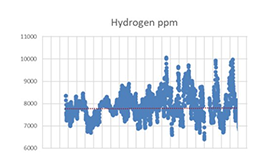 In this transformer, the dissolved gas levels were alarmingly high, but other than diurnal fluctuations, the H2 level was modestly steady. No immediate action was required; however, the gas levels and temperature were monitored daily for any larger excursions. Plans were made to degas when it reached 10,000 ppm. This scenario is typical of transformers operating in high-harmonic environments with significant renewable generation, where inverters create harmonics that heat up the transformer core. It’s not an internal transformer fault.
In this transformer, the dissolved gas levels were alarmingly high, but other than diurnal fluctuations, the H2 level was modestly steady. No immediate action was required; however, the gas levels and temperature were monitored daily for any larger excursions. Plans were made to degas when it reached 10,000 ppm. This scenario is typical of transformers operating in high-harmonic environments with significant renewable generation, where inverters create harmonics that heat up the transformer core. It’s not an internal transformer fault.
- Distinguished normal harmonics from actual fault
- Avoided false alarm and unnecessary shutdown
- Enabled planned degassing versus emergency response
Case Study 3: Actual Fault Detection
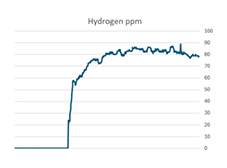 This case saw a rapid rise in gassing that was sustained for two weeks, even though the transformer was not loaded (just energized). This pattern is typical of transformer fault onset. A manual DGA sample was drawn, with the resultant Duval analysis indicating winding damage with arcing. The transformer was drained and inspected, and the failure mode was validated—the secondary winding had become compromised. Had the transformer been loaded, the failure would have been severe.
This case saw a rapid rise in gassing that was sustained for two weeks, even though the transformer was not loaded (just energized). This pattern is typical of transformer fault onset. A manual DGA sample was drawn, with the resultant Duval analysis indicating winding damage with arcing. The transformer was drained and inspected, and the failure mode was validated—the secondary winding had become compromised. Had the transformer been loaded, the failure would have been severe.
- Identified winding damage while the transformer unloaded
- Avoided severe damage by detecting before loading
- Validated fault mode before costly repairs
Case Study 4: Hardware Fault Prevention
A transformer triggered an H2 alarm through continuous monitoring. Manual DGA confirmed arcing activity, prompting immediate physical inspection. Investigation revealed a loose connection that was tightened and repaired. If left undetected and therefore untouched, over time the arcing would have melted interior steel parts and damaged the unit to the point of necessitating factory repairs. This would put the transformer out of service for at least nine months for transport, repair and return. Instead, the hydrogen monitoring detection and alarm enabled the local maintenance crew to fix a minor issue. The hydrogen detection and responsive action of the maintenance team avoided what could have been a catastrophic failure and a subsequent service disruption, successfully returning the transformer to service.
- Rapid detection of hardware faults
- Enabled timely repair intervention
- Prevented major capital loss
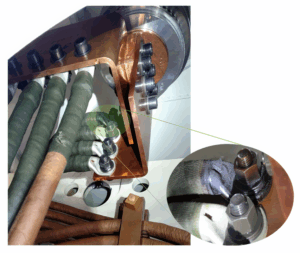
The Bottom Line: Intelligence Over Alarms
These case studies demonstrate two important principles:
- How unlike a smoke detector single gas monitors truly are: They provide nuanced, actionable intelligence rather than binary alarm states
- How valuable online transformer monitoring of hydrogen sensors is: These systems deliver context-aware insights that optimize maintenance decisions and prevent costly failures
Importantly, intelligent monitoring directly protects capital investments by enabling condition-based maintenance that can save millions on replacement costs and years of lead time delays.
With transformer lead times stretching out to years instead of months, replacement costs soaring and grid reliability under increasing pressure, utilities can’t afford the false alarms and missed faults that come from outdated monitoring approaches.
Adding a single gas monitor is a cost-effective solution for the entire fleet. Instead of choosing one or a select group of transformers to receive DGA monitoring, the entire fleet can be equipped with the early warning detection systems that provide continuous monitoring to the hospitals, the financial center and the residential areas.
Myth Debunked: A Smart Investment for Grid Reliability
Single gas hydrogen sensor monitors have very little in common with smoke detectors. They are, in fact, a very cost-effective way to determine the condition of a transformer fleet across HV and MV grids because they provide insight into the state of the fleet, driving action only when needed—and driving the right action based on sophisticated analysis rather than binary alarms.
In an era where almost every kilowatt-hour of electricity flows through a distribution transformer and replacement lead times stretch years, intelligent monitoring isn’t just beneficial, it’s essential for grid reliability and financial prudence.
The comparison to smoke detectors isn’t just wrong, it’s a dangerous oversimplification that could cost utilities millions and compromise grid reliability. It’s time to move beyond this myth and embrace the sophisticated intelligence that modern monitoring technology provides.
Ready to move beyond the “smoke detector” myth and implement intelligent transformer monitoring? Contact our team to learn how modern hydrogen sensor technology and dissolved gas analysis can provide actionable insights to optimize maintenance schedules, prevent costly failures and extend transformer life. Don’t let outdated thinking compromise your grid reliability—discover the difference between alarms and intelligence.

